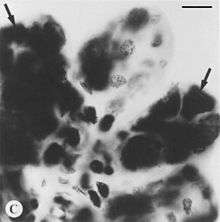Deer tick virus
| Deer tick virus | |
|---|---|
 | |
| Black and white microphotograph of Feulgen stained, intact tick salivary glands infected by deer tick virus. Hypotrophied salivary acinus filled with amorphous masses of pinkstaining (=Feulgen positive) material (arrows). Scale bar = 10 µm. | |
| Virus classification | |
| Group: | Group IV ((+)ssRNA) |
| Family: | Flaviviridae |
| Genus: | Flavivirus |
| Species: | Powassan virus |
Deer tick virus is a virus causing tick-borne encephalitis.[1]
Deer tick virus is a flavivirus closely resembling Powassan virus (to which it has 94% amino acid sequence identity).[2][3] Because they are so related, deer tick virus is thought to be a genotype of Powassan virus, and also called Powassan virus lineage II.[4]
In 1997, it was isolated from Ixodes scapularis (the deer tick, formerly Ixodes dammini) collected in Massachusetts and Connecticut.[5]
Phylogram

Phylogram indicating the relationship of deer tick virus to other tick-borne encephalitis group viruses.TBE, tick borne encephalitis; TSE, Turkish sheep encephalitis; GGE, Greek goat encephalitis; LI, louping ill virus; SSE, Spanish sheep encephalitis; KFD, Kyasanur Forest disease virus; TYU, Tyuleniy virus; SRE, Saumarez Reef virus.
Values above branches indicate bootstrapped confidence values. Branch lengths are proportional to percent similarity in sequence.
Values above branches indicate bootstrapped confidence values. Branch lengths are proportional to percent similarity in sequence.
See also
- Tick-borne encephalitis virus
- Lyme disease (caused by a deer-tick bacterium)
Footnotes
- ↑ Tavakoli NP, Heng W, Dupuis M et al. (2009). "Fatal Case of Deer Tick Virus Encephalitis". N. Engl. J. Med.. 360: 2099-2107.
- ↑ Kuno G, Artsob H, Karabatsos N, Tsuchiya KR, Chang GJ (November 2001). "Genomic sequencing of deer tick virus and phylogeny of powassan-related viruses of North America". Am. J. Trop. Med. Hyg. 65 (5): 671–6. PMID 11716135.
- ↑ Beasley DW, Suderman MT, Holbrook MR, Barrett AD (November 2001). "Nucleotide sequencing and serological evidence that the recently recognized deer tick virus is a genotype of Powassan virus". Virus Res. 79 (1–2): 81–9. doi:10.1016/S0168-1702(01)00330-6. PMID 11551648.
- ↑ Ebel GD, Spielman A, Telford SR (July 2001). "Phylogeny of North American Powassan virus". J. Gen. Virol. 82 (Pt 7): 1657–65. PMID 11413377.
- ↑ Telford SR, Armstrong PM, Katavolos P, et al. (1997). "A new tick-borne encephalitis-like virus infecting New England deer ticks, Ixodes dammini". Emerging Infect. Dis. 3 (2): 165–70. doi:10.3201/eid0302.970209. PMC 2627606
 . PMID 9204297.
. PMID 9204297.
This article is issued from Wikipedia - version of the 5/22/2016. The text is available under the Creative Commons Attribution/Share Alike but additional terms may apply for the media files.